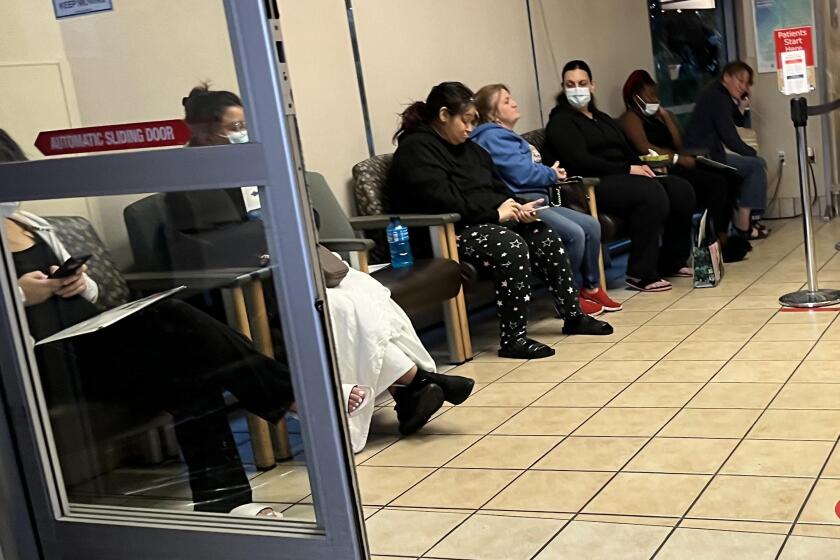Editorial: Stronger ozone standards are more than a moral and legal imperative
Decades after scientists described the ways in which air pollution scars and shrivels young lungs, groundbreaking research out of USC has delivered the good news that clean-air regulations are making a difference. In a longitudinal study that measured reductions in pollution in various neighborhoods around Los Angeles and then measured the lungs of children in those areas, researchers found that as air quality improved, the lungs of school-age children were bigger and healthier. The percentage of children with seriously impaired lung function dropped by more than half over the 17-year study period.
Yet back in the 1960s, when stricter air pollution controls were first proposed, representatives of the auto and manufacturing industries complained that it would be too expensive. The technology to accomplish it didn’t exist, they said. Jobs would be lost.
That familiar refrain is starting up again, now that the U.S. Environmental Protection Agency is proposing to tighten ozone standards. Newer studies have found that the existing standard of 75 parts per billion is still bad news for our lungs.
This is so-called ground pollution — not the ozone that forms a protective layer miles above Earth, but the mix of nitrogen oxides and volatile organic compounds that, when heated by the sun, forms the main component of smog.
The USC study, published this month, did not find evidence that improved lung health was attributable to lower levels of ozone. The reason is unclear. The scientific consensus on illness caused by smog is irrefutable; it’s the stuff that cancels gym classes on bad days and forces elderly people and asthmatics to stay indoors. One possibility mentioned in the study is that ozone levels have not dropped as much as those of other pollutants, such as fine particulates and nitrogen dioxide.
Los Angeles and many other counties in California have yet to meet even the existing federal standard. The region covered by the South Coast Air Quality Management District suffered through 93 days last year that were above 75 ppb, though that’s a big improvement over 200-plus days a year that were common during the late 1970s, and the 117 days in 2005. The EPA is proposing a new standard between 65 and 70 ppb; the precise level will be set after the public comment period that ends Tuesday.
In most of the nation, lowering the ozone level would be achievable within about five years, the EPA estimates, using air-pollution scrubbers in some factories and other readily available technology. But in Los Angeles, the San Francisco Bay Area and much of the Central Valley, as well as the most polluted counties outside the state, the obstacles would be formidable and then some. L.A. is supposed to meet the current level by 2032, which will require a 75% reduction in nitrogen oxide emissions from vehicles. A further reduction would entail a move to near-zero emissions from mobile sources — trucks, planes, trains and automobiles, the primary polluters. The EPA admits that would require actions that can’t fully be defined at this point and for which better technology might have to be developed.
Yet lowering ozone standards isn’t just a moral and legal imperative — the Clean Air Act mandates healthful air regardless of the cost of attaining it — it’s also a smart move economically. The EPA estimates that it would save up to $100 billion in medical expenses and lost work nationwide, more than the cost to industry of meeting stricter requirements.
But in making its decision, the EPA should consider two factors. Some of the smog in the L.A. air basin blows in from China, enough to make a difference of up to 2 ppb of ozone. The region will need federal help in negotiating agreements to eliminate that source.
Worse, the federal government has not adequately addressed its own lax rules regarding the levels of nitrogen oxides emitted by air traffic and the ships, interstate trucking and trains that are the backbone of port operations — major polluters in L.A. State and local governments are powerless to tighten these standards, which are based on average national pollution levels rather than local conditions. If the EPA plans to demand extraordinary clean-air efforts by municipalities, it has to do something about its own role in contributing to unhealthful pollution.
Follow the Opinion section on Twitter @latimesopinion and Facebook
More to Read
A cure for the common opinion
Get thought-provoking perspectives with our weekly newsletter.
You may occasionally receive promotional content from the Los Angeles Times.










